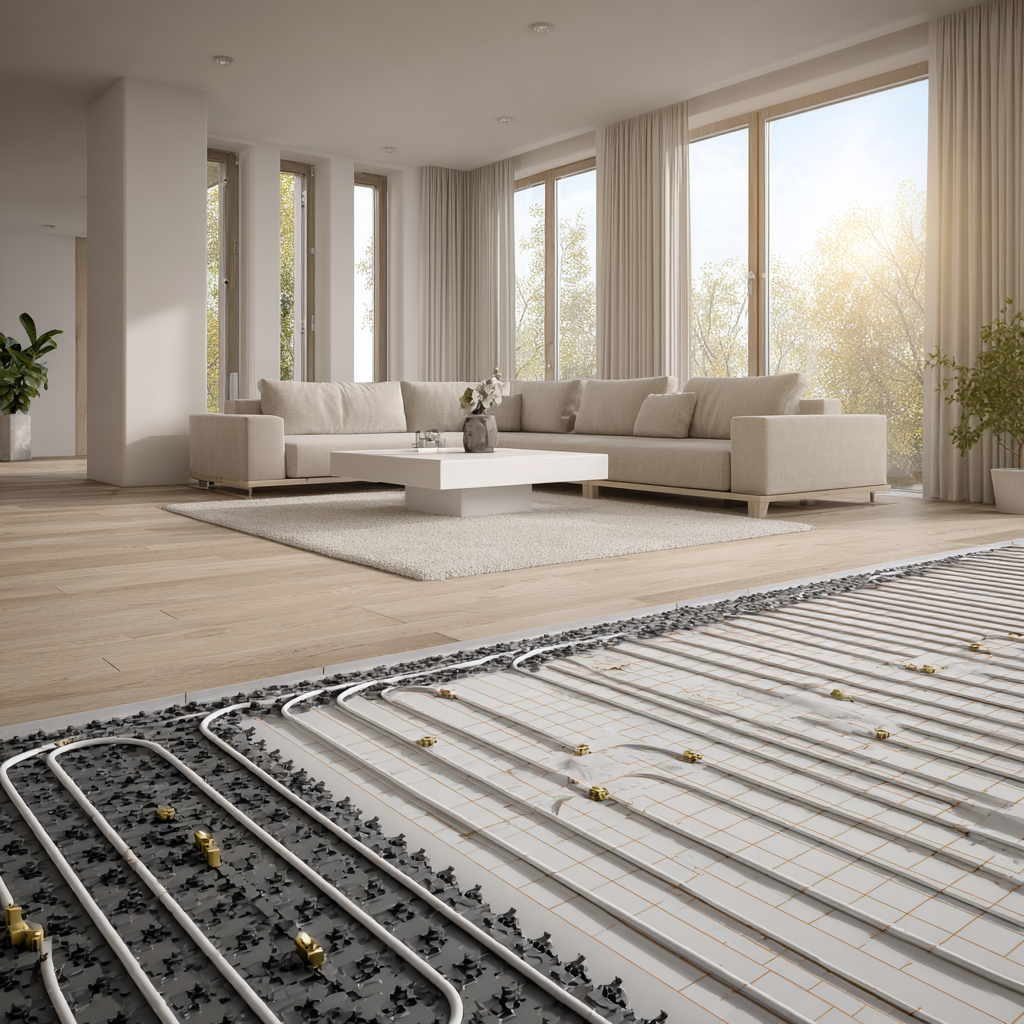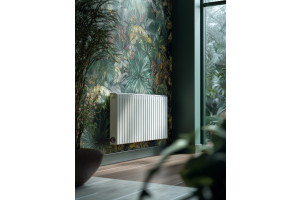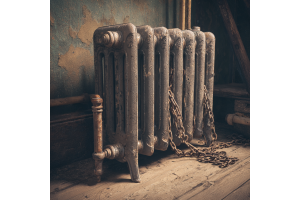
As heating technology advances and energy costs rise, many homeowners in the UK are reconsidering how best to heat their homes. Hybrid heating systems, combining underfloor heating (UFH) with radiators, are becoming increasingly popular. This article explores:
-
how underfloor heating and radiators differ
-
the advantages and disadvantages of each
-
how to combine them in a hybrid system
-
when a hybrid approach makes sense
-
what to watch out for (costs, controls, efficiency)
What Is Hybrid Heating?
Hybrid heating is a modern approach to home comfort that combines two or more heating technologies in a single, integrated system. Instead of relying solely on radiators or underfloor heating (UFH), a hybrid system strategically uses both — sometimes even pairing them with different heat sources like heat pumps and boilers — to maximise efficiency, flexibility, and comfort.
At its core, hybrid heating is about balance:
-
Underfloor heating delivers low-temperature, radiant warmth that feels natural and is particularly efficient in large, open spaces or rooms with hard flooring (such as kitchens, bathrooms, and living areas).
-
Radiators, on the other hand, provide quick, responsive heating and are especially useful in bedrooms, hallways, or rooms that aren’t used continuously.
By combining the two, homeowners can enjoy the steady, energy-saving background warmth of UFH while still having the rapid heat boost radiators provide when needed.
How Hybrid Heating Works
A hybrid heating system is carefully designed to ensure that each element complements the other, rather than competing:
-
Separate Circuits, One Heat Source
Both UFH and radiators can be connected to the same boiler or heat pump. However, because they operate best at different water temperatures, the system uses mixing valves and manifolds to ensure each gets the right flow temperature:-
UFH typically requires 35–45°C water.
-
Radiators usually need 55–75°C water, though modern low-temperature radiators can work at lower ranges.
-
-
Zoning & Smart Controls
Rooms are divided into “zones” with independent thermostats. For example:-
UFH may keep the living room at a consistent 21°C throughout the day.
-
Radiators in bedrooms may be programmed to switch on only in the evening and morning for quick warmth.
-
-
Integration with Heat Sources
-
If using a heat pump, the UFH side is naturally efficient because both run on lower flow temperatures. Radiators in this setup may need to be upsized to deliver enough heat at lower temps.
-
If using a gas or oil boiler, radiators can still operate at higher temperatures, while UFH zones are regulated down with a mixing system.
-
Some advanced setups use a dual-fuel system (e.g., heat pump for most of the heating, boiler backup for extreme cold snaps).
-
Benefits of Hybrid Heating
-
Comfort – Even warmth from UFH underfoot in main living areas, with the option of rapid heat in rooms where it’s needed.
-
Energy Efficiency – UFH’s low flow temperature reduces running costs, especially with renewable energy sources like air-source or ground-source heat pumps.
-
Flexibility – Ideal for homes where full underfloor heating isn’t possible (e.g., upstairs rooms in a retrofit). Radiators fill the gap.
-
Future-Proofing – Hybrid systems make the transition to low-carbon heating smoother. You don’t need to replace every radiator at once; UFH can be introduced gradually.
-
Zoned Heating Control – Reduces wasted energy by tailoring heat delivery to how each space is used.
Typical Use Cases in the UK
-
New builds or extensions – UFH is installed in open-plan kitchens/living spaces, while radiators serve bedrooms and smaller upstairs rooms.
-
Retrofits – Homeowners add UFH to a renovated ground floor, keeping radiators upstairs to avoid major disruption.
-
Energy upgrades – Hybrid systems allow households to add a heat pump without replacing every radiator, phasing upgrades over time.
In short, hybrid heating is about choosing the right tool for the right job. Radiators give speed, UFH gives efficiency and comfort, and together they create a system that adapts to the modern household’s needs.
Underfloor Heating vs Radiators: Key Differences
Here are some of the main factors in comparing underfloor heating and radiators.
| Feature | Underfloor Heating (UFH) | Radiators |
|---|---|---|
| Heat distribution & comfort | Provides even, gentle warmth from the floor up; fewer cold spots; radiative + convective heating. global.purmo.com+3Grand Designs Magazine+3Wunda+3 | Localised heating; heat rises then cools, may get more stratification (ceiling warm, floor cold). Quick bursts of heat possible. Stelrad Radiators+2Grand Designs Magazine+2 |
| Operating temperature | Works at lower flow temperatures (eg ~35-45°C for water systems) which suit heat pumps well. Environmental Protection+3Grand Designs Magazine+3Nu-Heat+3 | Often requires higher temperatures to achieve desired output, especially in poorly insulated or older properties. Nu-Heat+2Stelrad Radiators+2 |
| Energy efficiency & running costs | Generally more efficient long-term; lower energy consumption; best when combined with renewable sources. UFH can save ~25-40% over radiators when properly installed and combined with heat pumps. Nu-Heat+2Environmental Protection+2 | Possibly cheaper to install; quicker to heat up; may cost more to run in cold weather or with high temperature requirements. Stelrad Radiators+2Environmental Protection+2 |
| Installation cost & complexity | Higher upfront costs; more disruptive (floor work, raising floor levels, screed or panels, insulation) especially in retrofit situations. Grand Designs Magazine+1 | Lower upfront cost; simpler to install, especially in existing homes. Less disruption. Stelrad Radiators+1 |
| Response time | Slower to heat up and slower to cool down because of thermal mass (floor + screed). Less suitable if you want rapid temperature changes or intermittent use. Grand Designs Magazine+1 | Radiators can respond quickly; ideal for zones or rooms that are used intermittently, or when you need rapid heating. Stelrad Radiators+1 |
| Design & aesthetics | Invisible emitters; more flexibility in furniture placement; cleaner look. Warmup+1 | Takes up wall space; may restrict layout; visible units; can be a design feature in themselves. Stelrad Radiators+1 |
| Flooring & retrofit constraints | Needs good insulation below; choice of floor coverings matters (tiles, stone, some woods conduct well; thick carpets or certain materials insulate too much and reduce performance). Floor height may need to increase. Grand Designs Magazine+2Environmental Protection+2 | Less constraint on flooring; no changes needed to floor height; obviously no screed etc. Nu-Heat+1 |
| Maintenance & lifespan | Once installed correctly, relatively low maintenance. Less prone to needing frequent adjustment or cleaning. However, some systems can have durability issues depending on components. Warmup+1 | Established technology; parts are familiar; maintenance (bleeding radiators etc.) is simple and well understood. Radiators may need replacing more often than UFH systems in some cases. Homebuilding+1 |
When Does Hybrid Heating Make Sense?
Hybrid heating isn’t just a trend — it’s a practical solution for many UK homes where a “one-size-fits-all” heating method simply doesn’t work. While some properties benefit from full underfloor heating (UFH) or all-radiator systems, many households gain more comfort, efficiency, and flexibility by combining the two. Below are the most common scenarios where hybrid heating proves its worth.
1. Homes with Mixed Room Types
Not all rooms behave the same thermally:
-
Large, open-plan living areas (like kitchens, lounges, and dining spaces) suit UFH because it spreads gentle, even warmth across a big area.
-
Smaller or intermittently used rooms (like bedrooms, studies, or utility rooms) may be better served by radiators, which provide quick, responsive heat only when needed.
Hybrid heating allows you to match the emitter to the space, maximising comfort while avoiding wasted energy.
2. Retrofit and Renovation Projects
Full-house UFH retrofits can be costly and disruptive, requiring raised floor levels, screeds, or specialist panels. With hybrid heating, you can:
-
Install UFH only on the ground floor or in extensions, where it’s easier to integrate.
-
Keep radiators in upper floors or older parts of the house where flooring disruption isn’t practical.
This staged approach makes hybrid heating a budget-friendly compromise for renovators.
3. New Builds and Extensions
In new builds or major refurbishments, hybrid systems are often the smartest design choice:
-
UFH can be laid into the slab or screed during construction, at little extra effort.
-
Bedrooms and upstairs spaces can still use radiators, reducing build costs while ensuring quick morning and evening warmth.
This blend also gives future flexibility — homeowners can later upgrade radiators to low-temperature models if moving to a heat pump.
4. Pairing with Low-Temperature Heat Sources
Heat pumps and some modern boilers operate most efficiently at lower water flow temperatures:
-
UFH naturally thrives at these lower temperatures.
-
Radiators, however, may struggle unless they’re oversized or upgraded.
A hybrid system allows you to use UFH as the primary heating method in main living areas while relying on radiators (appropriately sized) for supporting rooms. This ensures the heat pump runs efficiently without compromising comfort.
5. Balancing Slow vs Fast Heat Response
Underfloor heating is steady but slow — it can take hours to heat up or cool down due to the floor’s thermal mass. Radiators, on the other hand, respond within minutes.
-
UFH is ideal for spaces you want to keep consistently warm.
-
Radiators are perfect for rooms used on a stop-start basis (like guest bedrooms or home offices).
In a hybrid setup, you get the best of both worlds: background comfort from UFH, with a quick boost from radiators where lifestyle demands it.
6. Improving Energy Efficiency Without Overspending
Not every homeowner can afford a full UFH installation throughout the property. Hybrid heating is a cost-efficient middle ground:
-
UFH reduces energy bills in high-use areas.
-
Radiators remain a lower-cost option for the rest of the house.
Over time, this balance often delivers long-term savings compared to a full radiator system, while keeping installation costs lower than full-house UFH.
7. Future-Proofing for Net Zero Homes
With the UK moving toward low-carbon heating solutions and phasing out traditional boilers, hybrid systems provide a transition pathway:
-
You can keep radiators now but install UFH in select areas.
-
Later, if you switch to a heat pump, you already have part of the system optimised for low-temperature operation.
This staged approach avoids large, one-time upgrade costs.
8. Lifestyle and Comfort Priorities
Every household has unique patterns:
-
Families with children may love the warm floors in playrooms and bathrooms from UFH.
-
Busy professionals may prefer radiators in home offices that can heat up instantly during working hours.
-
Elderly homeowners may appreciate the consistent, draft-free warmth of UFH while still relying on radiators in less-used rooms.
Hybrid systems give flexibility to tailor heating to daily routines.
In summary: Hybrid heating makes sense when your home (or lifestyle) demands different things from different spaces. Whether it’s retrofit challenges, open-plan layouts, heat pump compatibility, or simply wanting both steady warmth and quick-response heating, a hybrid system provides the flexibility to meet those needs — often with better comfort and energy savings than a single method alone.
Key Technical Considerations for Hybrid Systems
Designing and installing a hybrid heating system is not as simple as combining underfloor heating (UFH) with radiators. To get the most out of both technologies, you need to consider how they interact with the heat source, controls, pipework, and building fabric. Poorly designed systems can cancel out the benefits of hybrid heating, leading to higher running costs, uneven comfort, or frequent maintenance issues.
Here are the most important technical factors homeowners — and installers — need to account for:
1. Flow Temperature Management
-
Different requirements:
-
UFH works best at 35–45°C flow temperatures.
-
Traditional radiators often need 60–75°C to achieve the same comfort levels.
-
-
The challenge: If both are supplied from the same boiler or heat pump without proper regulation, either the UFH will run too hot (damaging floors and reducing efficiency) or the radiators will feel underpowered.
-
The solution:
-
Use mixing valves, manifolds, and pump sets to ensure UFH zones receive lower water temperatures.
-
If using a heat pump, consider oversized or low-temperature radiators designed for 40–50°C operation.
-
2. Zoning and Smart Controls
-
Hybrid systems only work efficiently if each part of the house can be controlled independently.
-
Best practice:
-
Install multiple zones with room thermostats. For example:
-
UFH zone for the ground floor (steady background warmth).
-
Radiator zones for bedrooms or upstairs (quick-response heating).
-
-
Invest in smart heating controls that allow scheduling, occupancy sensing, and remote adjustments.
-
-
Why it matters: Without zoning, you could end up heating the entire system unnecessarily, wiping out energy savings.
3. Heat Source Compatibility
-
Boilers:
-
Gas and oil boilers can serve both UFH and radiators, but condensing boilers are more efficient at low return temperatures (as in UFH). Radiators running at very high temps can reduce efficiency.
-
-
Heat pumps:
-
Work most efficiently at low flow temperatures, making UFH an excellent partner.
-
Radiators in hybrid systems may need to be upgraded or upsized to maintain comfort at lower temperatures.
-
-
Dual-fuel systems:
-
Some hybrids combine a heat pump with a boiler, automatically switching between them depending on outside temperature. This requires advanced controls and careful commissioning.
-
4. System Balancing and Hydraulics
-
Hydraulic balancing ensures that each radiator and UFH loop receives the right flow rate.
-
UFH circuits need careful pipe spacing and loop length design to avoid hot/cold spots.
-
Manifolds with individual flow meters and actuators help fine-tune UFH performance.
-
Radiators should be sized and balanced relative to the overall system, particularly if operating at lower temperatures.
5. Insulation and Building Fabric
-
UFH is only as efficient as the insulation beneath it. Without rigid floor insulation boards or panels, much of the heat can be lost downward.
-
For radiators, wall insulation and double/triple glazing reduce heat loss, allowing them to run at lower flow temperatures.
-
Hybrid systems rely heavily on the building’s overall energy efficiency to deliver savings. A poorly insulated property may negate the advantages of UFH altogether.
6. Flooring Considerations
-
UFH needs flooring with good thermal conductivity: stone, ceramic tile, polished concrete, and some engineered woods.
-
Thick carpets, rubber, or vinyl can restrict heat transfer, making UFH less effective.
-
Floor height increases (due to UFH layers) must be considered in retrofit projects, especially where doors, skirting boards, or stairs could be affected.
7. Response Times and Heat Retention
-
UFH has a slow thermal response due to the screed mass — it may take hours to heat up or cool down.
-
Radiators are fast-response emitters.
-
To avoid comfort issues:
-
Use UFH in rooms that benefit from steady, all-day warmth (open-plan living, bathrooms).
-
Use radiators in spaces where short bursts of heat are needed (bedrooms, studies).
-
-
Smart thermostats with “learning” features can predict heat-up times for UFH, helping avoid delays.
8. Controls and System Integration
-
Mixing valves and manifolds are essential to regulate UFH temperatures.
-
Modern control systems can manage UFH and radiators separately while coordinating with the heat source for efficiency.
-
Integration with renewable energy (solar PV + battery, or thermal storage tanks) is increasingly popular: UFH can act as a thermal store, absorbing excess renewable heat when available.
9. Maintenance and Lifespan
-
UFH systems, once installed correctly, require minimal maintenance, but:
-
Air locks, pump failure, or poor pipework design can cause issues.
-
Access panels to manifolds must be left clear for future servicing.
-
-
Radiators are simpler to maintain (bleeding, occasional replacement).
-
In a hybrid system, annual servicing should include:
-
Boiler/heat pump checks.
-
UFH manifold inspection.
-
Control calibration.
-
10. Cost vs Benefit
-
Upfront costs are higher due to additional pipework, manifolds, valves, and controls.
-
Running costs can be significantly lower if designed well — especially with a heat pump.
-
Long-term benefits include:
-
Improved comfort.
-
Lower energy bills.
-
Future readiness for the UK’s transition to low-carbon heating.
-
In short: The success of a hybrid heating system depends less on the components themselves and more on the design, sizing, and controls. If properly engineered, UFH and radiators can complement one another perfectly — but if poorly planned, the system may underperform or cost more to run.
Advantages & Disadvantages of Hybrid Systems
Hybrid heating systems combine underfloor heating (UFH) and radiators into one integrated setup. Like any solution, they come with both benefits and trade-offs. Here’s a detailed breakdown to help you weigh whether it’s the right choice for your home.
Advantages of Hybrid Heating
1. Best of Both Worlds
-
UFH provides consistent, radiant warmth that feels natural and luxurious underfoot.
-
Radiators offer fast, on-demand heating for rooms used intermittently.
-
Together, you get a system that adapts to both steady background heating and quick-response needs.
2. Zoned Comfort & Flexibility
-
UFH is perfect for open-plan living areas, bathrooms, and kitchens where you want continuous warmth.
-
Radiators can serve bedrooms, studies, and hallways that don’t need all-day heating.
-
Homeowners can customise heating strategies per room, improving comfort while reducing wasted energy.
3. Energy Efficiency Potential
-
UFH runs at low flow temperatures (35–45°C), making it highly compatible with renewables like heat pumps.
-
Radiators can be optimised with thermostatic radiator valves (TRVs) and smart controls.
-
By using UFH for baseline heating and radiators for short bursts, energy use can be lower compared to an all-radiator system.
4. Design & Aesthetic Freedom
-
UFH is invisible, freeing up wall space in main living areas.
-
Radiators, when chosen well (designer, vertical, or compact models), can double as decor features in other rooms.
-
Hybrid systems allow you to enjoy the clean look of UFH where aesthetics matter most while keeping radiators where practicality wins.
5. Future-Proofing & Transition to Low-Carbon Heating
-
With the UK pushing toward net zero and banning new gas boilers in 2035, many households are considering heat pumps.
-
A hybrid system allows a gradual transition: you can install UFH now and keep radiators until you’re ready to upgrade them.
-
This staged approach avoids costly, whole-house overhauls.
6. Increased Property Value
-
Buyers often see UFH as a premium feature, especially in kitchens, bathrooms, and open-plan spaces.
-
A hybrid setup can make a home more attractive, signalling both comfort and energy efficiency.
7. Lifestyle Tailoring
-
Families with children benefit from warm play areas thanks to UFH.
-
Professionals can rely on instant radiator heat in home offices.
-
Elderly homeowners often prefer UFH’s draft-free, even heat, improving comfort and health.
Disadvantages of Hybrid Heating
1. Higher Upfront Costs
-
You’re effectively installing two systems in one house.
-
Costs include extra pipework, manifolds, mixing valves, controls, and in some cases, upgraded radiators.
-
More expensive than sticking with either UFH-only or radiator-only setups.
2. Installation Complexity
-
Requires expert design to balance water temperatures, flow rates, and zoning.
-
Mistakes (e.g., undersized radiators or poorly insulated floors) can cause inefficiency.
-
Not all heating engineers are experienced in hybrid systems, so finding the right installer is critical.
3. Potential Disruption in Retrofits
-
Installing UFH often means lifting floors, raising floor levels, or applying new screed.
-
In older homes, this can be messy, time-consuming, and costly.
-
Radiators may remain the only realistic option upstairs unless slimline retrofit UFH panels are chosen.
4. Complex Controls & Maintenance
-
With two different types of emitters, homeowners may need to learn a more advanced control system.
-
Mixing valves, pumps, and manifolds require occasional servicing.
-
If controls aren’t well set up, you could end up overheating or underheating zones, negating efficiency benefits.
5. Slower vs Faster Response Times Can Clash
-
UFH is slow to react — once it’s warm, it stays warm, but it takes time to heat up.
-
Radiators heat up quickly, which may tempt users to over-rely on them, raising energy bills.
-
Without smart scheduling, this difference in response can cause uneven comfort.
6. Space & Access for Equipment
-
UFH requires a manifold system (usually installed in a cupboard, utility room, or hallway).
-
Radiator pipework also needs balancing.
-
For smaller properties, accommodating both sets of equipment can be tricky.
7. Not Always Cost-Effective in Poorly Insulated Homes
-
In older, draughty houses, UFH can struggle because heat loss is too high.
-
In such cases, the efficiency benefit may not justify the higher installation cost.
-
Investing in insulation upgrades first often delivers better returns before installing hybrid heating.
Weighing It Up
Hybrid heating shines in:
-
Modern new builds (UFH in open-plan areas + radiators upstairs).
-
Renovations or extensions (UFH in new spaces + radiators in existing rooms).
-
Homes preparing for heat pumps (low-temperature UFH now, radiators phased out later).
It may not be ideal for:
-
Small homes or flats where wall space is less of an issue and full UFH is unnecessary.
-
Poorly insulated homes where heat losses cancel out efficiency gains.
-
Tight budgets, since upfront costs can be 20–40% higher than a single system.
In summary: Hybrid heating delivers unmatched flexibility, comfort, and future-proofing — but it comes at the cost of higher complexity and installation expense. For many UK households, especially those modernising or planning for renewable heat, the advantages outweigh the disadvantages. However, careful design and proper insulation are the key to ensuring the system pays back in efficiency and comfort.
Cost Comparisons & Payback
When weighing underfloor heating (UFH), radiators, or a hybrid system, cost is often the deciding factor. While hybrid heating offers the flexibility of both technologies, it does mean balancing higher upfront investment with potential efficiency savings over time.
Upfront Installation Costs
The initial outlay depends on whether you’re working with a new build (easiest for UFH) or a retrofit (more disruptive).
-
Radiators only:
-
Standard panel radiators: £150–£350 each installed.
-
Designer or vertical radiators: £300–£700 each installed.
-
Typical 3–4 bedroom home: £2,000–£4,000.
-
-
Underfloor heating only:
-
Wet UFH (water-based) in a new build: £50–£90 per m².
-
Wet UFH retrofit: £70–£120 per m² (higher due to floor lifting, screed, or overlay panels).
-
Whole-house system for 3–4 bed home: £8,000–£16,000 depending on size.
-
-
Hybrid system (UFH + radiators):
-
Combination often costs 20–40% more than radiators-only.
-
Example: UFH downstairs (~£5,000–£7,000) + radiators upstairs (~£2,500–£4,000).
-
Add manifolds, mixing valves, and advanced controls: £500–£1,500 extra.
-
Typical hybrid install for a medium home: £9,000–£12,000 in new builds, rising to £12,000–£18,000 for retrofits.
-
Running Costs
The real advantage of UFH lies in its low operating temperature, which makes it cheaper to run — especially with renewables like heat pumps. Radiators, by contrast, generally require higher flow temperatures.
-
Radiators (boiler-fed):
-
Flow temp: 55–75°C.
-
Gas bills typically higher because the boiler must work harder.
-
Example: Average gas-heated UK home spends £1,200–£1,600/year (2025 rates).
-
-
Underfloor Heating:
-
Flow temp: 35–45°C.
-
More efficient with condensing boilers, significantly cheaper with heat pumps.
-
Running costs can be 10–25% lower than radiator-only systems in a well-insulated home.
-
-
Hybrid Heating:
-
UFH provides the baseline warmth for high-use rooms (e.g., open-plan living, kitchen).
-
Radiators deliver targeted bursts in rooms used intermittently.
-
If managed well with smart controls, hybrid heating typically reduces annual bills by 10–20% compared with radiator-only.
-
Long-Term Payback Potential
Hybrid systems cost more upfront, but their efficiency can pay back over time — especially if paired with a heat pump.
-
Short term (1–5 years):
-
Higher initial outlay means you won’t see immediate savings.
-
Payback depends on energy prices, usage patterns, and insulation levels.
-
-
Medium term (5–10 years):
-
Energy savings begin to offset installation costs.
-
Homes with smart zoning and good insulation typically save £200–£400 per year on bills versus radiator-only systems.
-
-
Long term (10–20 years):
-
Over the system’s lifespan, savings can reach £3,000–£6,000 compared with radiators, particularly in large or open-plan homes.
-
With a heat pump, the payback is faster because UFH and low-temperature radiators both optimise pump efficiency.
-
New Build vs Retrofit
-
New builds: Hybrid heating makes the most financial sense here. Floors can be designed for UFH from the start, minimising extra costs. Payback period: 8–12 years.
-
Retrofits: More expensive due to disruption and floor modifications. Payback can stretch to 12–18 years, unless major renovations are already underway.
Key Factors That Affect Payback
-
Insulation levels – Poorly insulated homes see little benefit; well-insulated homes maximise UFH efficiency.
-
Energy source – Hybrid with a gas boiler saves some money; hybrid with a heat pump delivers much bigger returns.
-
Usage patterns – Families who use most rooms daily will see greater benefits than those who only heat select areas.
-
Smart controls – Proper zoning and scheduling can make or break savings.
Bottom Line
-
Cheapest upfront: Radiators only.
-
Most efficient long-term: Underfloor heating with a heat pump.
-
Best balance: Hybrid heating — higher initial investment, but greater comfort, flexibility, and future-proofing.
For many UK households, especially those building new or upgrading with renewables, hybrid heating can pay back its extra cost within 10–15 years, while offering superior comfort from day one.
Case Studies & Practical Examples
While hybrid heating may sound complex in theory, many UK homes are already using it successfully. The following examples illustrate how different types of properties and homeowners can benefit from combining underfloor heating (UFH) with radiators.
Case Study 1: New Build Family Home (Open-Plan Living)
-
Property: 4-bedroom detached new build, Surrey.
-
System Setup:
-
UFH throughout the ground floor (open-plan kitchen, dining, and living space).
-
Vertical designer radiators in upstairs bedrooms and bathrooms.
-
Gas boiler with smart zoning controls.
-
-
Why Hybrid Made Sense:
-
The open-plan ground floor benefited from UFH’s even warmth and freed up wall space for furniture and décor.
-
Radiators upstairs offered quick heat on demand, perfect for bedrooms used mainly in mornings and evenings.
-
-
Results:
-
Energy bills were cut by ~18% compared to a neighbour’s radiator-only system.
-
Comfort levels improved — especially in winter mornings when the UFH kept the ground floor consistently warm without “cold spots.”
-
Case Study 2: Victorian Terrace Retrofit (Limited Floor Disruption)
-
Property: 3-bedroom Victorian terraced house, Manchester.
-
System Setup:
-
Retrofit UFH in the kitchen extension at the rear (installed using slimline overlay panels).
-
Traditional cast-iron-style radiators in the lounge, hall, and bedrooms.
-
Combination gas boiler with TRVs on radiators.
-
-
Why Hybrid Made Sense:
-
Installing UFH throughout the house would have been costly and disruptive due to original flooring.
-
UFH in the extension provided cosy warmth in the family’s main living area, while radiators preserved the period look in older rooms.
-
-
Results:
-
Bills reduced by around £250/year thanks to the UFH operating at lower flow temperatures.
-
The kitchen extension became the most comfortable room in the house, encouraging more family use.
-
Case Study 3: Renovated Barn Conversion (High Ceilings)
-
Property: Barn conversion in Yorkshire with vaulted ceilings and exposed beams.
-
System Setup:
-
UFH across the ground floor using a ground-source heat pump.
-
Oversized low-temperature radiators on the upper floor.
-
Smart controls with multiple heating zones.
-
-
Why Hybrid Made Sense:
-
High ceilings made radiator-only heating inefficient.
-
UFH provided steady radiant heat from the floor up, while low-temp radiators upstairs complemented the heat pump system.
-
-
Results:
-
Running costs were 40% lower than a comparable oil boiler setup.
-
The system qualified for the government’s Boiler Upgrade Scheme grant, helping with installation costs.
-
Case Study 4: Modern Apartment (Space-Conscious Design)
-
Property: 2-bedroom apartment in London.
-
System Setup:
-
Electric UFH in the bathroom and kitchen.
-
Slimline vertical radiators in bedrooms and living room.
-
Smart electric heating controls linked to a mobile app.
-
-
Why Hybrid Made Sense:
-
Limited floor depth meant whole-home UFH wasn’t practical.
-
Electric UFH added luxury and comfort where tiled floors would otherwise feel cold.
-
Radiators were chosen for efficiency and to avoid raising floor levels.
-
-
Results:
-
The owner reported improved comfort without compromising usable space.
-
Running costs remained manageable due to careful zoning and use of electric UFH only in high-impact areas.
-
Practical Takeaways
-
Extensions & renovations: Add UFH to new spaces while keeping radiators elsewhere to control costs and disruption.
-
New builds: Full flexibility — UFH downstairs, radiators upstairs is the most popular choice.
-
Large or complex properties: Hybrid systems with heat pumps deliver long-term savings and comfort.
-
Flats & smaller homes: UFH in bathrooms/kitchens paired with radiators elsewhere provides comfort without structural upheaval.
In short: hybrid heating isn’t just a “one-size-fits-all” concept. It adapts to the property type, lifestyle, and budget — from modern apartments to period terraces and large barn conversions.
Recommendations for Homeowners
Choosing between radiators, underfloor heating (UFH), or a hybrid system can feel overwhelming, especially when factoring in budgets, running costs, and future energy regulations. Here are clear recommendations to help you decide if hybrid heating is right for your home — and how to approach the process with confidence.
1. Assess Your Home’s Suitability
Before committing, consider your property’s age, layout, and insulation:
-
New builds & extensions: Hybrid heating is usually a smart choice. UFH can be integrated easily into ground floors, while radiators upstairs keep installation costs manageable.
-
Retrofits in older homes: Full-house UFH may be costly and disruptive. Instead, target UFH in extensions, kitchens, or open-plan areas, while retaining radiators elsewhere.
-
Insulation check: Hybrid heating performs best in well-insulated homes. If your property has draughts, poor loft insulation, or single-glazed windows, upgrade insulation first for maximum efficiency.
2. Think About Your Heat Source
Your heating system’s efficiency depends on the heat source:
-
Gas or oil boiler: Hybrid systems work well, but ensure a proper mixing valve setup for UFH.
-
Air-source or ground-source heat pump: Hybrid setups shine here, as UFH and low-temperature radiators are designed for lower flow temperatures. This is the most future-proof choice.
-
Electric UFH: Best reserved for small areas (e.g., bathrooms) as running costs are higher, but it pairs neatly with radiators in the rest of the home.
3. Plan for Smart Controls & Zoning
Hybrid heating only delivers real benefits if zones are carefully managed:
-
Zoning by room type: Keep UFH running steadily in main living areas, while radiators upstairs can be scheduled for mornings/evenings.
-
Smart thermostats: Use programmable or app-based controls to avoid overheating or wasting energy.
-
Individual TRVs on radiators: Fine-tune bedroom and hallway heating without affecting the whole system.
4. Balance Costs with Long-Term Value
-
Upfront costs: Hybrid systems are more expensive than radiator-only setups. Expect to invest 20–40% more.
-
Running costs: If well-designed, savings of 10–20% annually are possible compared to radiator-only systems.
-
Grants & incentives: Look into UK schemes like the Boiler Upgrade Scheme (BUS) for heat pumps, which reduce installation costs significantly.
-
Payback: For many homeowners, hybrid heating pays back in 10–15 years, with comfort improvements felt immediately.
5. Work With the Right Installer
Hybrid heating systems require careful design and balance between two technologies. To avoid costly mistakes:
-
Choose an installer with experience in both UFH and radiator systems.
-
Ask for a heat loss calculation — this ensures each room gets the right output.
-
Check that they specify quality manifolds, pumps, and mixing valves, not budget shortcuts.
6. Match the System to Your Lifestyle
-
Families: UFH in living spaces ensures cosy comfort for children, while radiators make bedrooms warm quickly.
-
Couples or professionals: Smart zoning prevents wasting energy in unused rooms.
-
Elderly homeowners: Draft-free UFH in living areas improves comfort, while radiators maintain flexibility.
-
Design-focused homeowners: Use UFH to maximise wall/furniture space, and choose stylish radiators for areas where emitters are still visible.
7. Future-Proof Your Home
With the UK moving away from fossil fuel heating, think long-term:
-
If you plan to switch to a heat pump in the future, consider hybrid heating now to reduce radiator reliance later.
-
Prioritise low-temperature radiators upstairs so they’re already compatible with future low-carbon heating sources.
-
Hybrid heating offers flexibility: you can expand UFH or upgrade radiators gradually without committing to a full overhaul today.
Key Takeaways for Homeowners
-
Hybrid heating is most beneficial in new builds, renovations, and extensions.
-
Always improve insulation first — it multiplies the benefits of hybrid heating.
-
Choose smart controls to get the most efficiency out of your system.
-
Think of hybrid heating as a long-term investment: it enhances comfort immediately and reduces running costs over time.
-
Work with a reputable installer who can design a system tailored to your property and lifestyle.
In short: If you want the comfort of UFH, the flexibility of radiators, and the efficiency to prepare for a low-carbon future, hybrid heating is worth serious consideration.
Conclusion: Finding the Right Balance with Hybrid Heating
Choosing between radiators, underfloor heating (UFH), or a hybrid system is ultimately about balancing comfort, efficiency, and practicality. Each solution has clear strengths: radiators provide quick, responsive heat; UFH delivers consistent, even warmth; and hybrid systems combine the two to give homeowners the best of both worlds.
What sets hybrid heating apart is its flexibility. You don’t have to commit fully to one approach — instead, you can tailor your system to your home’s layout, your lifestyle, and your long-term energy goals. For example:
-
A new build with open-plan living spaces may use UFH downstairs for steady background warmth, while radiators upstairs provide fast heat when needed.
-
An older home undergoing renovation might integrate UFH in an extension or kitchen, while keeping radiators in other areas to control costs and disruption.
-
A property preparing for a heat pump can combine UFH with low-temperature radiators, making the transition to renewable heating smoother and more cost-effective.
From a financial perspective, hybrid systems do require a higher upfront investment. However, with smart controls, proper zoning, and good insulation, they can deliver 10–20% lower annual running costs compared with radiator-only systems — not to mention the lifestyle and comfort benefits. Over 10–15 years, many households see a return on investment, while enjoying a warmer, more adaptable home in the meantime.
Most importantly, hybrid heating is a future-proof solution. With the UK moving toward low-carbon heating and the phase-out of new gas boilers, systems designed to operate at lower flow temperatures will become increasingly valuable. By choosing hybrid heating now, you’re not only improving today’s comfort but also preparing your home for tomorrow’s energy landscape.
At the end of the day, the right choice depends on your home, your budget, and your priorities. But if you want:
-
The luxury of underfloor heating where it matters most,
-
The reliability and flexibility of radiators where practicality wins,
-
And the efficiency to cut energy costs and support a greener future...
Hybrid heating may be the smartest investment you can make.
At Geyser, we specialise in radiators and heating solutions that fit seamlessly into hybrid systems. Whether you’re planning a new build, renovating, or upgrading for the future, our expert team can help you choose the right products to create a system that’s efficient, stylish, and built to last.







